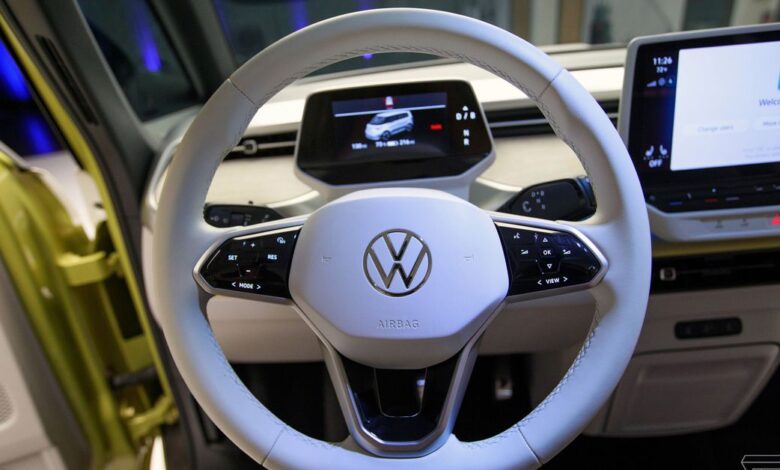Volkswagen’s software problems are causing customer headaches — and leading to major EV shakeups

During the year that he owned a 2021 Volkswagen ID.4, Branden Flasch came to believe that the electric crossover SUV did many things very well. But when it came to the car’s software-based functions — the infotainment system, the various controls, smartphone integration, and so on — “it was death by a thousand cuts,” Flasch said.
Flasch said he experienced problems with scheduling charging at home and had trouble getting the car to get along with Apple CarPlay. He had an “obnoxious” experience with the ID.4’s much-lamented capacitive controls, which eschew actual buttons for touch panels that offer haptic feedback.
“It was death by a thousand cuts.”
His experience has not been isolated. Owners of VW’s electric ID cars all over the world have reported problems with infotainment screens, range calculations, buggy smartphone connections, charging, and other features that are far more seamless on other companies’ cars. And VW’s long-promised addition of over-the-air updates, increasingly common on other cars, is just now starting as of this month, but still not in North America.
Flasch is an old hand at EVs, having owned several, including a Tesla Model S he drove for 100,000 miles. (“I essentially lived out of that car for nine months during the worst of COVID,” he said.) He makes YouTube videos about his experiences with EVs; in his day job, he develops EV charging stations and infrastructure for a major convenience store chain.
But when he got a chance to part with his ID.4 for only $1,200 less than he paid for it, he did so, trading up for a Polestar 2 and then a Rivian R1T.
Flasch said he sold the Volkswagen more for financial reasons than anything else, but the software headaches are not missed.
“As a vehicle, not talking about like infotainment and software, it’s fantastic,” Flasch said. “There are very few vehicles that are that good, realistically.” But, he added, “I would say Volkswagen is a bit behind the curve [on software] compared even to the other legacy automakers.”
Software problems have emerged as a major roadblock to the entire Volkswagen Group’s electric vehicle plans. So much so that VW Group CEO Oliver Blume is due to outline a revised software strategy at the carmaking giant’s supervisory board meeting on Thursday, December 15th. The meeting has been described by outlets like Automotive News as a “reality check,” where Blume will be expected to present a more grounded plan to realize VW’s ambitious and expensive electric dreams.
“The Volkswagen Group is undergoing the biggest transformation in its history.”
“The Volkswagen Group is undergoing the biggest transformation in its history,” a VW Group spokesperson said in an email. “Our NEW AUTO Group strategy sets out a clear roadmap up to 2030 for us to become a sustainable software-oriented mobility provider. We have to transform ourselves and acquire completely new competencies if we want to play a leading role in tomorrow’s mobility market. Software will become the new differentiator.”
Blume knows the cost of not getting this right. He took the CEO job in September after his predecessor Herbert Diess was fired over clashes with unions and software issues.
The Volkswagen Group’s software problems are well-documented and reflective of wider issues facing many legacy automakers. As they aim to compete with new players like Tesla and Rivian and transform their vehicles into essentially battery-powered computers on wheels, they find themselves forced to become software companies as well as manufacturing companies.
This transition has not been an easy one.
“It’s pretty clear that software and the way a consumer interacts with the vehicle are some of the most critical areas of focus for automakers, particularly for EVs,” said Paul Waatti, the industry analysis manager for AutoPacific, an automotive marketing research and consulting firm. “It’s no longer just mechanical and dynamic advantages that stand out like with internal combustion. It’s software and the overall user experience that will ultimately set vehicles apart.”
“It’s pretty clear that software and the way a consumer interacts with the vehicle are some of the most critical areas of focus for automakers, particularly for EVs.”
For the VW Group, the stakes could not be higher. It’s not just a conglomerate that includes Audi, Porsche, Ducati, and Bentley that’s either the biggest or second-biggest car company in the world, depending on how Toyota is performing that quarter. It’s the car company undertaking one of the most aggressive pivots to electric vehicles, driven in part to seek penance for getting caught cheating on diesel emissions in 2015. That even included founding Electrify America, its public EV charging subsidiary.
In the years since, the VW Group has committed to phasing out its internal combustion engines in Europe by 2035, building six battery “gigafactories” in Europe meant to supply millions of EVs, and electrifying all of its brands, even Lamborghini.
Plus, automakers like VW have high aspirations for new revenue sources beyond just selling cars, and those, too, depend on software. These include features like connected cars, leveraging data, subscription features, integrating e-commerce and augmented reality into vehicles, virtual assistants, and other features that could redefine how we think of cars entirely.
To achieve any of that, Volkswagen must get the software right. And so far, it has not.
Photo by Amelia Holowaty Krales / The Verge
‘Why does it want me to hate it?’
In the increasingly electrified and digitally-focused automotive world, “software” can refer to a great many things. It can mean the programs that govern more complex functions like semi-autonomous driver assistance systems, battery management, navigation, over-the-air updates, and interactions with various charging networks. It can also refer to more conventional features that drivers have spent the last two decades getting increasingly accustomed to, like infotainment systems and smartphone integration.
In Volkswagen’s case, it’s “all of the above.”
The original ID.3, a compact hatchback sold in Europe and other markets as a close sibling of America’s ID.4 crossover, was delayed at launch over software problems. The other ID cars have received considerable backlash in China over issues like sudden blank infotainment screens. Owners and car testers alike in America have reported issues with nonresponsive infotainment screens, problems with charging route planning, inaccurate tire pressure readings, charging connectors not unlocking, smartphone integration errors, and other pains.
Nonresponsive infotainment screens, problems with charging route planning, inaccurate tire pressure readings, and more
All of this has added up to a frustrating ownership experience for many people, said Will Kaufman, a senior writer and content strategist at the automotive shopping site Edmunds. The publication added a 2021 ID.4 to its long-term testing fleet in March, and it has since reported a number of software-related technical problems.
“One of our editors titled an article, ‘Why does the 2021 Volkswagen ID.4 want me to hate it?’” Kaufman said. “A lot of that came down to just bugs and unexpected behavior… Apple CarPlay has been a huge problem for us. We’ve had just tons of connectivity issues.”
It’s a tough break for the ID.4, which is meant to be the tip of the spear for the new Volkswagen in America — one eager to move past its diesel-cheating past and into a cleaner, greener future. It’s a crossover so directly aimed at mainstream Americans that it’s aimed at the ubiquitous Toyota RAV4, something priced to convince families everywhere that they, too, can break up with gasoline for good. Along with the ID.3, it also launched the MEB platform, an electric vehicle architecture meant to underpin a small army of VW Group cars in the years to come.
“This is up against the Mustang Mach-E, the [Hyundai] Ioniq 5, the [Kia] EV6,” Kaufman said. “These are really important vehicles for these brands, sort of laying out what their future is and getting new consumers onboard.”
It’s a tough break for the ID.4, which is meant to be the tip of the spear for the new Volkswagen in America
Kaufman said the root cause of the ID cars’ software issues — a few of which have extended to conventional, gas-powered VW vehicles using some of the same systems — is unclear, although he believes it has something to do with the many all-new technologies that made their debuts here.
“They rolled out a lot of new stuff for this vehicle,” Kaufman said. “This is not really carrying much over from other [vehicles].”
But while VW’s struggles illustrate the pitfalls involved with car companies developing software in-house, it also shows what car companies will risk now for fear of being left behind. AutoPacific’s Waatti recalled such a conversation with another automaker recently.
“One of their biggest fears was that they’d become a supplier to a software company,” he said. “That’s a reality that could happen. So [a company] like Volkswagen who has as deep pockets as they do, I think that they’re not necessarily willing just to hand off that huge portion of the vehicle’s future to an outside brand.”
Some automakers are taking a different approach. Volvo and Polestar have turned their UX over to Google’s Android Automotive, and Ford’s Android-based Sync infotainment stack arrives next year. And Apple — which has had its own set of troubles developing a car in-house — appears to have similarly ambitious software plans, which will hardly be ignored by automakers.
Waatti said he can understand why automakers are reluctant to cede software entirely to other entities. “But I think on a big level, it’s to their detriment,” he said. “I think a company like Volkswagen should be focusing more on their core knowledge base, which is developing and building cars. Not software.”
Photo by Amelia Holowaty Krales / The Verge
Trinity delayed
While issues with infotainment screens have been around as long as that feature has existed, they don’t often lead to CEOs getting fired. That’s because VW’s problems extend beyond the screens and have affected new car rollouts, plans for future factories, and big goals around eventual autonomous driving.
In 2021, Volkswagen announced “Project Trinity,” a new high-end electric flagship sedan. But it was more than just a car; it was meant to usher in the successor to the MEB platform, called SSP, and was to debut a whole new range of technologies for VW, including a high level of autonomous driving and new software-based business models. At the time, the VW brand’s CEO called it “a lighthouse project, our software dream car.” Furthermore, it was to be built at an all-new 2 billion euro factory in Wolfsburg, Germany, starting in 2026.
VW’s problems extend beyond the screens and have affected new car rollouts, plans for future factories, and big goals around eventual autonomous driving
That dream has since been met with a hard reality check. According to Reuters, since taking the reins, VW Group CEO Blume is now evaluating whether to build the vehicle at that new plant or do so at an existing one. A new software platform due to be used on Project Trinity has also reportedly been delayed. More recently, VW announced “substantial further development” to its MEB platform called MEB Plus, indicating the more revolutionary SSP project will be punted down the road.
In other words, VW could well stick with what it has now while sorting out its software issues and scaling up its battery tech and production before promising the future of electric and autonomous driving.
“It’s pretty clear they’re going to have to direct a lot of resources to the software, and I think that definitely stalled some of their future plans,” Waatti said.
Yet in spite of all of these software problems and the questions of whether VW’s “e-mobility” ambitions can ever be realized if it can’t get Apple CarPlay syncing right, many current owners still sing the praises of their ID.4s. It’s made a number of publications’ “best” lists, has lured over many first-time EV owners, and despite the supply chain issues that have dogged the entire industry, it’s even been selling well. And an update — albeit one that must be installed at a dealership, not over the air, like a Tesla — rolled out in December beginning with 2021 ID.4 models adds some much-needed features, like better charging route planning, display updates, and what VW calls “minor bug fixes.”
“We are continuously working to improve and enhance the digital experience for our consumers, beginning with updated software for MY21 ID.4s,” a Volkswagen USA spokesman said in a statement.
“We are continuously working to improve and enhance the digital experience for our consumers, beginning with updated software for MY21 ID.4s.”
Miguel Menjivar is one of those owners who’s still happy with his purchase. The Claremont, California resident said he’s owned his ID.4 since last October, and he’s “very much enjoyed” the car so far despite “minor glitches.”
“Maybe because it’s my first EV, I don’t have anything else to compare it to. I love the ride, the pickup, the interior and the overall look,” Menjivar said. “Could it be better? Everything can be better, but nothing would dissuade me from getting a second.”
But, in another example of how VW’s software isn’t quite on par with some competitors like Tesla, where Supercharging works seamlessly without the aid of a phone app, Menjivar said he wished his car had the plug-and-charge feature that’s now available on the 2023 models.
“I would love it if I could plug in [to] Electrify America, and it would recognize my car,” he said.
Source link






